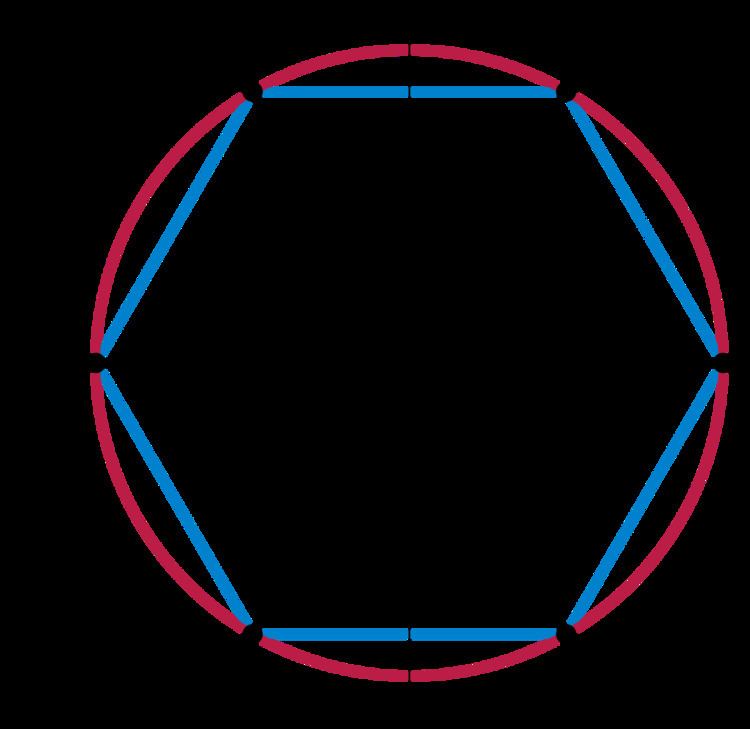 | ||
In mathematics, an alternating group is the group of even permutations of a finite set. The alternating group on a set of n elements is called the alternating group of degree n, or the alternating group on n letters and denoted by An or Alt(n).
Contents
Basic properties
For n > 1, the group An is the commutator subgroup of the symmetric group Sn with index 2 and has therefore n! / 2 elements. It is the kernel of the signature group homomorphism sgn : Sn → {1, −1} explained under symmetric group.
The group An is abelian if and only if n ≤ 3 and simple if and only if n = 3 or n ≥ 5. A5 is the smallest non-abelian simple group, having order 60, and the smallest non-solvable group.
The group A4 has a Klein four-group V as a proper normal subgroup, namely the identity and the double transpositions { (), (12)(34), (13)(24), (14)(23) }, and maps to A3 = C3, from the sequence V → A4 → A3 = C3. In Galois theory, this map, or rather the corresponding map S4 → S3, corresponds to associating the Lagrange resolvent cubic to a quartic, which allows the quartic polynomial to be solved by radicals, as established by Lodovico Ferrari.
Conjugacy classes
As in the symmetric group, the conjugacy classes in An consist of elements with the same cycle shape. However, if the cycle shape consists only of cycles of odd length with no two cycles the same length, where cycles of length one are included in the cycle type, then there are exactly two conjugacy classes for this cycle shape (Scott 1987, §11.1, p299).
Examples:
Relation with symmetric group
See Symmetric group.Generators and relations
An is generated by 3-cycles, since 3-cycles can be obtained by combining pairs of transpositions. This generating set is often used to prove that An is simple for n ≥ 5.
Automorphism group
For n > 3, except for n = 6, the automorphism group of An is the symmetric group Sn, with inner automorphism group An and outer automorphism group Z2; the outer automorphism comes from conjugation by an odd permutation.
For n = 1 and 2, the automorphism group is trivial. For n = 3 the automorphism group is Z2, with trivial inner automorphism group and outer automorphism group Z2.
The outer automorphism group of A6 is the Klein four-group V = Z2 × Z2, and is related to the outer automorphism of S6. The extra outer automorphism in A6 swaps the 3-cycles (like (123)) with elements of shape 32 (like (123)(456)).
Exceptional isomorphisms
There are some exceptional isomorphisms between some of the small alternating groups and small groups of Lie type, particularly projective special linear groups. These are:
More obviously, A3 is isomorphic to the cyclic group Z3, and A0, A1, and A2 are isomorphic to the trivial group (which is also SL1(q) = PSL1(q) for any q).
Subgroups
A4 is the smallest group demonstrating that the converse of Lagrange's theorem is not true in general: given a finite group G and a divisor d of | G |, there does not necessarily exist a subgroup of G with order d: the group G = A4, of order 12, has no subgroup of order 6. A subgroup of three elements (generated by a cyclic rotation of three objects) with any additional element generates the whole group.
For all n ≠ 4, An has no nontrivial (i.e., proper) normal subgroups. Thus, An is a simple group for all n ≠ 4. A5 is the smallest non-solvable group.
Group homology
The group homology of the alternating groups exhibits stabilization, as in stable homotopy theory: for sufficiently large n, it is constant. However, there are some low-dimensional exceptional homology. Note that the homology of the symmetric group exhibits similar stabilization, but without the low-dimensional exceptions (additional homology elements).
H1: Abelianization
The first homology group coincides with abelianization, and (since
This is easily seen directly, as follows.
For
H2: Schur multipliers
The Schur multipliers of the alternating groups An (in the case where n is at least 5) are the cyclic groups of order 2, except in the case where n is either 6 or 7, in which case there is also a triple cover. In these cases, then, the Schur multiplier is (the cyclic group) of order 6. These were first computed in (Schur 1911).
